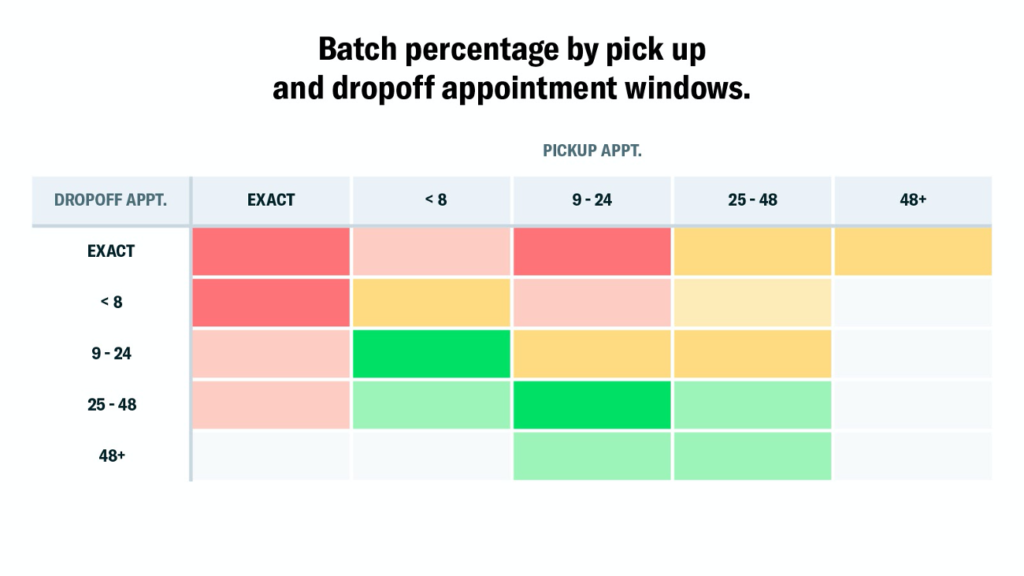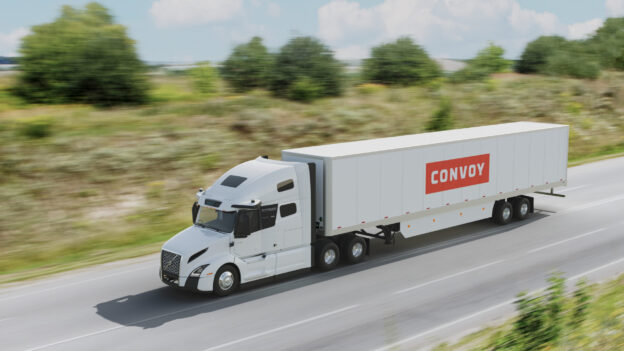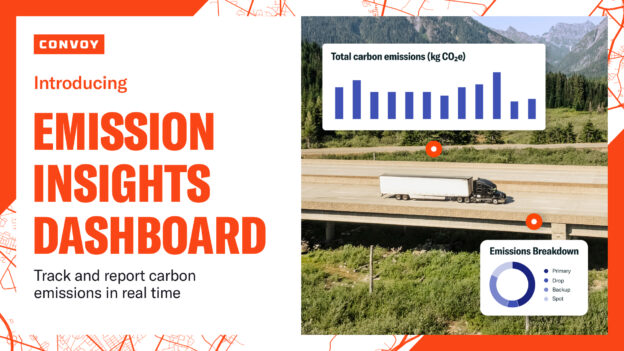Green Appointment Windows and Their Impact on Sustainability
Sustainability • Published on May 19, 2020
Due to the fragmented nature of the trucking industry, Convoy’s digital freight network provides opportunities for shippers and drivers to experience efficiency gains, and it is no different when it comes to sustainability. One area of active research for Convoy is shipment appointment setting, and in this article, we’ll be talking specifically about its impact on environmental sustainability.
Roughly speaking, there are two variations of shipment appointments: “exact” appointments, where the shipment appointment is set as one exact date and time, and “window” appointments, where the appointment is set on a time range (for example, a pickup appointment set from Monday, 8:00 AM, to Tuesday, 12:00 PM).
“Window” appointments — which we call “Green Appointments” at Convoy – have a meaningful impact on reducing carbon emissions on two major fronts: (1) reducing wait times at stops, and (2) decreasing empty miles since flexible appointment windows make it easier to optimally group a shipment with earlier and later shipments.
Analyzing thousands of shipments delivered through Convoy’s network with green appointment windows over the past year, we estimate that drivers experience a 67% decrease in wait times, leading to about 14 lb / shipment decrease in CO2 emissions, and an average of about a 36% improvement in empty miles, leading to about 289 lb / shipment decrease in CO2 emissions.
Reduced Wait Times = Reduced CO2 Emissions
How do reduced wait times lead to decreased CO2 emissions? This analysis is based on the insight that if a driver spends less time waiting to pick up or drop off a load, then the driver will spend less time idling. Despite the reality that idle reduction technologies now exist for trucks, according to the US Department of Energy (DOE), each year more than 6 billion gallons of diesel fuel are wasted by idling vehicles, and trucks burn around 4 billion of that total. So, every effort towards reducing idling time for trucks count. With Green Appointment Windows, drivers have the flexibility to choose pick up and drop off times that are more optimal to their schedules, leading to shorter wait times.
An obvious question is: Why don’t drivers just turn off their engines as they wait? According to interviews and observations on ride-alongs conducted by Convoy’s User Design team, drivers rarely just switch off their engines while waiting because they do not know how long they will have to wait, and frequently turning an engine on and off can cause excessive (and costly) wear and tear on the engine. There is some debate about whether or not keeping trucks’ engines on is actually better than turning the engine off, but regardless, referring back to the 4 billion gallons of diesel fuel figure above, idling is a big part of environmental inefficiencies in trucking.
Providing More Efficient Wait Times through Green Appointment Windows
Controlling for a wide range of features that should influence wait times — including the truck type (e.g., dry vans, reefers), facility, and seasonal factors — we estimate that the average wait time was 14 minutes (67%) shorter for loads with a Green Window, compared to loads with an exact appointment. This time saving translates into a carbon emission savings of 14 lbs of CO2 for every load that is scheduled with a Green Window instead of an exact appointment.
Reducing Empty Miles Through Better “Batches”
The Theory
A second way that Green Appointment Windows reduces CO2 emissions is in the area of empty miles driven. For both live and drop shipments, there is typically the need for some number of empty miles between a dropoff and the next pickup (sometimes with an intermediate stop to rest). However, if there is more flexibility in the dropoff and pickup times, there are more opportunities to find closer loads before and after any particular shipment.
Consider these two stylized scenarios:

In the first scenario,there is no flexibility to find a backhaul, because only jobs that are day-of and after 2:00 PM could be worked in. Not able to find a backhaul, all of the ride back home at empty miles.
Empty miles: ~300 mi.

In the second scenario, with more time to pick up and drop off, there is flexibility to schedule around these times to work on other shipments that also work with this shipment geographically. This means there is a higher chance for the driver to find a backhaul home, rather than drive those miles back empty.
Empty miles: ~0 mi.
So flexible shipping windows can increase the likelihood of round-trip combinations, leading to empty miles saved, which in turn leads to significant savings in CO2 emissions.
The Data
This makes sense intuitively, and Convoy’s data for shipments delivered since the inception of Automated Reloads (April 2019 – present) match the intuition. When we disaggregate pickup and dropoff appointments into categories ranging from exact to increasingly wider appointment windows (to the right and toward the bottom in the chart below), we see that the average proportions of shipments that got fit into an Automated Reload increases. (Green cells correspond to a higher proportion of shipments that are grouped into more efficient combinations of loads.)

For shipments with the most flexible Green Appointment Windows, we observed nearly all shipments scheduled as a part of an Automated Reload, compared to only about 5% for shipments with exact appointments.
Then, we leverage past research to quantify the impact of Green Appointment Windows on empty miles. Comparing empty miles per shipment for each shipment appointment window type, we found that when both pickup and dropoff appointments are exact appointments, the average empty miles is 206 miles; when the pickup and dropoff appointments are both windows, the average empty miles is 152 miles. This gives us the estimate that, on average, the exact appointments to Green Appointment Windows could increase the number of shipments that are grouped into pre-planned combinations, leading to up to an average deadhead savings of 54 miles (36%) per shipment. This translates to an average deadhead saving of 289 lbs of CO2 emissions in empty miles when we move from exact appointments to Green Appointment Windows.[4]
Conclusion
There is no single solution when it comes to reducing waste across the trucking industry and promoting environmental sustainability. But with Green Appointment Windows, shippers working with Convoy’s digital freight network can make a (potentially big) impact toward becoming more green. As Convoy’s platform grows, the depth and breadth of possible efficiency gains should continue to grow. Sustainability has been a core mission of Convoy from the very start, and we are just beginning to scratch the surface of more to be done in making trucking more efficient in every regard.
Acknowledgements
Huge thanks for Jen Wong, Aaron Terrazas, Charles Duze, and many others for reviewing & contributing to the content and delivery of this research!
Appendix
[1]
According to the Journal of the Air & Waste Management Association (pg. 358), the average diesel engine truck emits about 4400 g / hr of CO2 emissions. Converting that to lb / hr, we leverage this formula that on average, every hour of wait time leads to about 9.69 lbs of CO2 emissions.
Utilizing this formula, we split the data by stops with and without green appointment windows and compare CO2 emissions between the two groups. In attempt to compare apples-to-apples and filter out noise in our dataset, I created a dataset that controlled for seasonality, truck type (Dry Van and Reefer)[2]. Once the dataset was created, I controlled further for facility-based impacts on the results by looking at comparisons of wait time and CO2 emissions for exact vs green appointment windows appointments for the same facility:[3]
| Appointment Type | MEDIAN WAIT TIME | Median CO2 Emission (LBS) |
| exact | 2.18 | 21.08 |
| green | 0.71 | 6.86 |
Full dataset of Idle wait times:
| APPT_WINDOW | AVG WAIT TIME | AVG LBS OF CO2 EMISSION | MEDIAN WAIT TIME | MEDIAN LBS OF CO2 EMISSION |
| 1. exact | 3.13 | 30.31 | 2.18 | 21.08 |
| 2. window | 1.96 | 19.02 | 0.71 | 6.86 |
This is an addition to the analysis results. We tried controlling for stop_type as well, and found that the median wait time shows minimal change between stop types, and the majority of wait time differences are between appointment window types.
Another interesting insight is that there is wide fluctuation between the 90th and 99th percentile in wait time for all 4 appointment window – stop type combinations. This indicates that, barring from data instrumentation errors, there could be a small population of facilities that have abnormally high wait times as compared to the typical facility.
| APPT_WINDOW | STOP_TYPE | 25th | MEDIAN | 75th | 90th |
| 1. exact | DROPOFF | 1.38 | 2.34 | 4.01 | 6.09 |
| 1. exact | PICKUP | 1.36 | 2.10 | 3.51 | 5.54 |
| 2. window | DROPOFF | 0.13 | 0.63 | 2.00 | 2.80 |
| 2. window | PICKUP | 0.34 | 0.71 | 2.00 | 4.07 |
To calculate CO2 emissions, we borrow some variables from the Environmental Defense Fund’s “Green Freight Handbook”[5] and other sources[6]:
- Average empty truck in North America = ~30,000lbs
- Average truck CO2 emission: ~161.8 g / CO2 / ton*mile
Putting this all together, this means that the empty miles savings of about 54 miles per shipment leads to:

We save about 131 kg, or ~289 lbs of CO2 emissions in empty miles when we move from exact appointments to Green Appointment Windows. Corresponding with the difference in empty miles, this is a 36% per shipment reduction in CO2 emissions.
[5]EDF, “Green Freight Handbook”, Pg. 9: https://storage.googleapis.com/scsc/Green%20Freight/EDF-Green-Freight-Handbook.pdf
[6]Quora: https://www.quora.com/How-much-does-the-average-big-rig-truck-weigh



